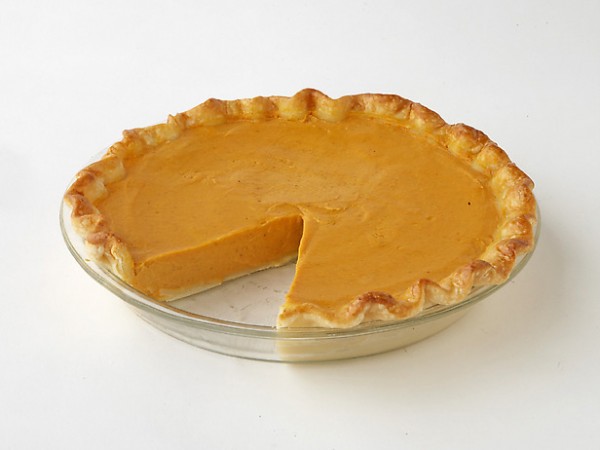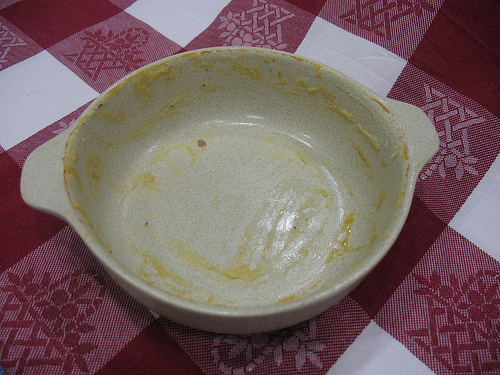In mathematics, you don't understand things. You just get used to them. -Johann von Neumann
Sometimes, I have to deal with series: lots of numbers all added together. Some series clearly approach a limit, like the following:
1 + 1/2 + 1/4 + 1/8 + 1/16 + 1/32 + ...
I can visualize this in terms of pies. (What do you want? I'm hungry!) One = one whole pie. So that first number starts me out with one whole pie.

When I add the second number in my series, I'm clearly adding half a pie to that, for a total of a pie and a half.

When I add the third term, I've now got one-and-three-quarters pies, and by adding the fourth term, I've got one-and-seven-eighths pies.

If I add more and more terms in this series, I'm going to get closer and closer to two whole pies, but I'll never quite reach it, always being just a tiny sliver away.
And that's okay! It means that the sum of this series is two. The series has a limit, or -- in math-speak -- the series converges.
But not all series converge! Take a look at this one:
1 + 1 + 1 + 1 + 1 + 1 + ...
The first term starts me out with a pie. Fine, so did the last series. But when I add the second term in, I realize I now have two pies!

In fact, if I add the third one in I have three pies, if I add the fourth in I get four pies, and so on! The more terms I add, the more pies I get.

This last part -- that the series doesn't approach a limit -- is really important. It means that I can keep adding more terms, but when I do, the value of the series keeps changing; it doesn't approach one single value. Therefore, this series does not converge, and the word we give to this is that the series diverges.
Or, to quote Lindsay Lohan (correctly) from Mean Girls, The Limit Does Not Exist!
But what if I were a tease about it? What if I gave you this series:
1 - 1 + 1 - 1 + 1 - 1 + 1 - 1 + ...
After one term, there is a pie, but after two terms, there aren't any pies; the second term takes the first pie away!
And it looks like the third term adds a pie, and the fourth one takes it away, and this continues. You're adding pies (one-by-one) and taking them away (one-by-one) as you keep on adding terms.

So you might ask yourself, does the series converge, and if it does, what is its limit?
A mathematician is likely to tell you that the limit does not exist. Why not? Because for half of the terms, the sum is one full pie. But for the other half of the terms, the sum is zero pies. I could group these terms together to show you. For example, if I put my parentheses like so:
( 1 - 1 ) + ( 1 - 1 ) + ( 1 - 1 ) + ( 1 - 1 ) + ( 1 - 1 ) + ...
it's clear that this series sums up to zero. But what if I'm clever, and I organize my terms like this:
1 + ( -1 + 1 ) + ( -1 + 1 ) + ( -1 + 1) + ( -1 + 1) + ...
I can see that my series sums up to one whole pie! So who's right: is it zero pies, one pie, or does the solution simply not exist? To get it right, you have to ask yourself what happens on average.

Well, for half of the terms you have a pie, and for the other half of the terms you have no pies. On average? You have half a pie. Even though at no point do you actually have half-a-pie, this series sums to one-half. (For more rigor, you might want to read this.)
1 - 1 + 1 - 1 + 1 - 1 + 1 - 1 + ... = 1/2.
This is a hard one to wrap your head around, and many mathematicians and physicists that I knew in graduate school were unable to do it. Want to try something more ambitious? Have a go at this one:
1 - 2 + 3 - 4 + 5 - 6 + 7 - 8 + ...
(Answer here.) And if this isn't up your alley, don't worry. We'll go back to the astrophysics on Wednesday.


"1 + ( -1 + 1 ) + ( -1 + 1 ) + ( -1 + 1) + ( -1 + 1) + ... "
Associativity is not defined on an infinite series.
I thought associativity was defined, but only if the series converged. And as far as I know, this series does not converge to 1/2 or any other number - even on average. For example, you could rearrange the terms to be: 1+1-1+1+1-1+1+1-1+ . . . or 1-1-1+1-1-1-1+1-1-1-1-1+1- . . . so that this series can go to any integer you care to name. Or to no finite integer, for that matter.
I noticed that you didn't use any meat pies in your analysis. Is there any significance to this? Do you think there is any possibility of a grant application?
[Evidently the comments here don't like me linking to my own weblog. Go there yourself and search on "associativity in series".]
The first couple of comments are close. I made two posts on the subject when I covered series.
However, even so: you won't drive any mathematicians crazy. What you're talking about here can be handled in two different ways.
First is "analytic continuation". For example, the geometric series doesn't converge at $x=-1$, but where it does converge it converges to the function $\frac{1}{1-x}$. This function can be evaluated at $x=-1$ to give the answer $\frac{1}{2}$.
Second is "Cesà ro summation". What we do here is replace the partial sum of the first $n$ terms with the average for the first $n$ partial sums. It turns out that if a series is summable, then it's also Cesà ro summable; but if it's not summable it might still be Cesà ro summable, and thus give us the right answer.
If the "many mathematicians and physicists" you knew really couldn't wrap their heads around it, then they never passed a basic course in Fourier analysis.
I'm no mathematician, but it doesn't seem correct to me to say that the limit of the average of the nth partial sum of a series can be considered to be the same as sum of a series. If the series is convergent, then they do end up being equal, but that is a special case.
For example, consider the trivial series sum(1^n). The partial sums would be 1,2,3,4,5,..., and the Cesaro summation as defined in the Wikipedia article would be 1/1, 2/2, 3/3, 4/4, 5/5, ... , or lim as n->infty(n/n) = 1 via L'Hopital's rule. However, it's a divergent series where lim as n->infty of s_n = infty, not an indeterminate value such as {1,-1}.
POTENTIAL SPOILER FOLLOWS
As far as your more ambitious question.... The Cesaro sum turns out oscillate between {1/2, -1/2} as n->infty. I haven't looked at the solution, and can't justify what I say next, but perhaps you could again apply the Cesaro sum to the oscillating terms of the partial sums and get 1/4?
Egaeus, You've made a mistake in your calculations. It's not the average of the sequence up to that point, it's the average of the partial sums. For example:
The sequence is
1, -1, 1, -1, 1, -1, 1, -1, ...
The sequence of partial sums is
1, 0, 1, 0, 1, 0, 1, 0, ...
The sequence of sums of partial sums is
1, 1, 2, 2, 3, 3, 4, 4, ...
The sequence of averages of partial sums is
1/1, 1/2, 2/3, 2/4, 3/5, 3/6, 4/7, 4/8, ...
Which converges to 1/2.
My calculations were for 1^n, not -1^n.
Okay, let's look at that one, Egaeus:
The sequence is
1, 1, 1, 1, 1, 1, 1, 1, ...
The sequence of partial sums is
1, 2, 3, 4, 5, 6, 7, 8, ...
The sequence of sums of partial sums is
1, 3, 6, 10, 15, 21, 28, 36, ...
The sequence of averages of partial sums is
1/1, 3/2, 6/3, 10/4, 15/5, 21/6, 28/7, 36/8, ...
Which diverges, just as it should. If a series diverges to infinity, it still does when Cesà ro summation is used.
Oh, duh, that's right. I did it right later, but not on that one. Now the solution for the second problem makes more sense. I could see what needed to be done, but couldn't justify it. It's too late for math after a day of paper writing, I guess. I knew something didn't look right in the first paragraph too.
But still, it doesn't seem correct to equate s and the limit of 1/n*sum(s_k}.
It's not too difficult to show that if the series converges then the sum and the Cesà ro sum are equal. Yeah, it does seem to be sort of a cheat at first, but when you see how it makes the inverse Fourier transform work out you get used to it quick.
You shouldn't throw together different types of summability, at least not without explicit warning.
Although on average you have half a pie, the function remains without a limit although it is bounded. You simply have to accept a very large error in stating the value. :)
If you wanted pies, You sould also have used the convergent series â(1/n²), whose sum is exactly ϲ/6; and also 1-1/3+1/5-1/7+... = Ï/4 (via power series expansion of arctangent), which was actually the formula used for centuries to compute Ï. By the way, this last one could even have a geometrical interpretation and be representable in pies, but I don't see it right now.
And for the divergent geometric series â(-1)^n : as John Armstrong says, analytic continuation hints at a sum = 1/2 (though it converges neither in â or âp), but you can also « cheat » by saying
S = 1 - 1 + 1 - 1 + 1 - 1 ...
= 1 - (1 - 1 + 1 - 1 + ...)
= 1 - S, thus S = 1/2.
(This is the exact same method used to compute the sum of a _convergent_ geometric series, but applied to the divergent case q=-1, it becomes confusing).
The correct answer is "Schrödinger's Pie".
Good.
Now deal with how 1+2+3+4+5+ ... = -1/12.
Hey Sili, that's amusing how (R) summation makes the familiar (1^3+2^3+3^3+...) = (1+2+3+...)^2 fail, considering that you have 1+2+3+4+5+... = -1/12 and 1^3+2^3+3^3+4^3+5^3+... = 1/120...
Oh, and a fun reference book on the subject is Hardy, _Divergent series_ (though, as all Hardy books, it is not easy reading!)
Especially when they are not the same thing; even Lebesgue integration and Riemannian integration are better equivalents. Such is the paucity of the mathematical vocabulary :-)
This is also a way to show that 1/1+1/2+1/3+... diverges (somewhat apocryphal, but supposedly the work of a law student): Let S=1/1+1/2+1/3+... and split it into even and odd parts, S=(1/1+1/3+1/5+...)+(1/2+1/4+1/6+...). But this is just S=(1/1+1/3+1/5+...)+(1/2)S, so that (1/2)S=(1/1+1/3+1/5+...), and termwise, 1/1>1/2, 1/3>1/4, etc. So this is a contradiction unless both parts sum to infinity.
I think that if you can show that 1+2+3+4+5+... = -1/12, then you might just overthrow the foundations of all mathematics....
Nigel Tufnel: The series all sum to eleven. Look, right across the board, eleven, eleven, eleven and...
Marty DiBergi: Oh, I see. And most series sum up to ten?
Nigel Tufnel: Exactly.
Marty DiBergi: Does that mean it's convergent? Is it any more convergent?
Nigel Tufnel: Well, it's Cesaro convergent, isn't it? It's not ten. You see, most blokes, you know, will be converging at ten. You're on ten here, all the way converged, all the way converged, all the way converged, you're on ten on your series. Where can you go from there? Where?
Marty DiBergi: I don't know.
Nigel Tufnel: Nowhere. Exactly. What we do is, if we need that extra push over the cliff, you know what we do?
Marty DiBergi: Converged it up to eleven.
Nigel Tufnel: Eleven. Exactly. One bigger.
Marty DiBergi: Why don't you just make ten more convergent and make ten be the top number and make that a little more convergent?
Nigel Tufnel: [pause] These converge to eleven.
I just ate the pie, please recompute for N=2 to infinity.
Saying it's 'right' that the sum is 1/2 is only justified if there's a theorem showing that any summability method for divergent series that leads to a reasonable set of properties is equivalent to Cesà ro summability (or that this particular series is a special case).
Otherwise you have the possibility of other 'right' answers under different sets of assumptions.
My knowledge maths isn't up to that - but I haven't heard that's the case.
"In mathematics, you don't understand things. You just get used to them. -Johann von Neumann"
This is a little bit funny, but as a mathematician, I can tell you: It is *not* true. And, well, no, today this not really funny any more, it is lame.
Ethan, don't get it wrong: Handling series like the ones you showed here is basic mathematics, and has been handled during the first couple of semesters at university. Nobody was driven crazy by this.
i love pie
hihihihihiihihihihihihihihi do you like pizza
do you like poo i most certainly do
Interesting math. Bravo for the idea!
http://kuhinjarecepti.com/